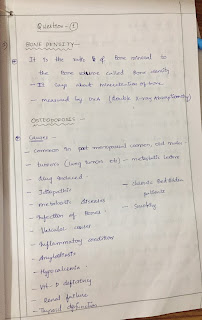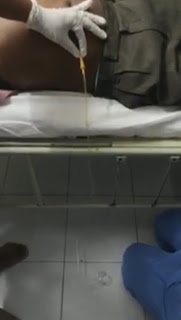Internal assessment-1
Question-1
Define bone density? How is it measured? What are the causes, clinical features ,diagnosis and management of osteoporosis?
Ans:

Supportive care-
Gentle warming with blankets,Broad spectrum antibiotics,high flow oxygen,and if required assisted ventilation
Correction of hyponatremia and hypoglycemia
Hydrocortisone (100mg ivsly,8hrly)is required due to increased metabolic stress
Thyroid hormone replacement-
T4- initially 100-150Micro gm and then 75-100 MCG iv is recommended
T4- - orally ina dose of 300mcg start followed by 100-300mcg daily
Treat precipitating causes
Causes; Rheumatic heart disease, ischemic heart disease, hypertension, thyrotoxicosis, congenital heart disesase, cardiomyopathy, pericardial diseases,rare causes; alcohol, pulmonary embolism
Symptoms; palpitations,fatigue,syncope,
Signs; irregularly irregular pulse
Absence of waves on jvp, hypotension,disappearance of psa of mid diastolic murmur of mitral stenosis
Disappearance of fourth heart sound
Diagnosis;
ECG; irregularly irregular rhythm of qrs complexes
Absent p waves
Small irregular waves at state of 350-600/minute
Complications ; syncope,angina, thromboembolism
Hypotension.
Management;
Goals;
Hemodynamic stabilization
Control of ventricular rate
Restoration of sinus rhythm
Treatment of underlying cause
1) if pt s clinical status is severely compromised synchronised dc cardioversion is treatment of choice
2) if pts cardioversion is not severely compromised treatment is in 2steps
*Slowing ventricular rate with diltiazem,verapamil,digoxin
Amiodarone; 150mg over 10 minutes followed by 1mg / minute over 6hrs and0.5mg/minute for another 18hrs
A/E; hepatic toxicity, pulmonary toxicity, thyroid dysfunction
2(converting rhythm to normal sinus rhythm
Pharmacological cardioversion to sinus rhythm with quinidine,flecanide
*Antithrombotic therapy
*Aspirin
*Refractory cases are managed with catheter ablation therapy
Hepatic cirrhosis,
*Malignant; hepatic, peritoneal
*Infection; tuberculosis,bacterial peritonitis
*Hypoproteinemia; Nephrotic syndrome, malnutrition
*Cardiac failure, constrictive pericarditis
*Hepatic venous obstruction; budd-chiari syndrome,veno occlusive disease
*Pancreatitis
*Lymphatic obstruction-chylous ascites
In common; meigs syndrome, vasculitis, Hypothyroidism,
Pathogenesis;
Ascites occurs due to imbalance between formation and resorption of peritoneal fluid.in cirrhosis of liver ascites is due to
* Portal hypertension
*Renal changes; increased sodium and water resorption.thre is stimulation of RAAS,increased ADH release and decreased release of natriuretic hormone or third factor
*Imbalance between formation and removal of hepatic and gut lymph
*Hypoalbunemia
*Elevated Padma vasopressin and epinephrine levels in response to volume depleted state accenuates renal and vascular factors
Differential diagnosis;
Acute liver failure,cirrhosis, budd-chiari syndrome,dilated cardiomyopathy, alcoholic hepatitis, biliary disease
UMN lesions;
*Weakness; voluntary movements are disturbed; distal predominant
Tone; hypertonia( claspknife spasticity)
*Reflex (tendon); increased,
*Reflex (superficial); absent or decreased
Plantar response; extensor
*Muscle atrophy; disuse
*Fasciculations ; absent
*Bilateral movements; spared
(Eyes,face,jaw,neck)
*Reaction of degeneration; absent
* Nerve conduction; normal
LMN lesions
Weakness; paralysis of muscles supplied by that segment or nerve proximalpredominant
Tone; hypotonia
*Reflex (tendon); decreased or absent
*Reflex (superficial); absent or decreased
Plantar response; flexor or absent
*Muscle atrophy; marked
*Fasciculations ; often present
*Bilateral movements; affected
(Eyes,face,jaw,neck)
*Reaction of degeneration; present
* Nerve conduction; abnormal
- Rheumatoid arthritis of the neck.
- Whiplash injury or other cervical spine trauma.
- Spinal infections.
- Spinal tumors and cancers
- Spondylosis
- Spinal cord compression or squeezed.
































Comments
Post a Comment